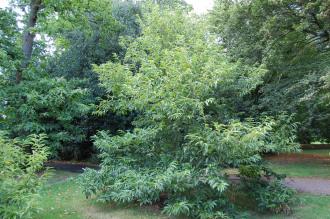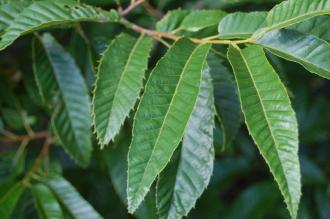
Castanea crenata (17/08/2014, Kew Gardens, London)
Position: Full sun to dappled shade
Flowering period: Late spring
Soil: Moist, well drained
Eventual Height: 15m
Eventual Spread: 10m
Hardiness: 4a, 4b, 5a, 5b, 6a, 6b, 7a, 7b, 8a, 8b
Castanea crenata is a deciduous broad leaf tree with a rounded habit. Its mid green leaves are ovate to lanceolate with toothed serrate margins, up to 19cm long and 5cm broad. Its leaves turn yellow/ bronze before they fall in autumn. Its monoecious flowers are catkins and up to 20cm long. Its female flowers then develop into spiny cupules which are up to 7cm across and contain edible chestnuts.

Castanea crenata Leaf (17/08/2014, Kew Gardens, London)
Castanea crenata, commonly known as Japanese Chestnut, is native to Japan and South Korea. In its native habitat it grows in deciduous woodland. This species of Castanea is mostly resistant to Chestnut Blight. Castanea crenata is synonymous with Castanea japonica.
The etymological root of the binomial name Castanea is derived from the Latin name for Chestnut. Crenata is derived from the Latin crena meaning ‘serration’, in reference to its leaves.
The landscape architect may find Castanea crenata useful as an attractive specimen tree. This tree should be thoughtfully sited as its fruit may cause a litter problem. Once established this tree is drought tollerant.

Castanea crenata Fruit (17/08/2014, Kew Gardens, London)
Ecologically, Castanea crenata fruit are attractive to some birds and mammals.
Castanea crenata prefers moist, fertile, well-drained soils. It tolerates most pH of soil. It will tolerate poor soils and very acidic soils.
Castanea crenata requires little maintenance.

